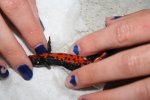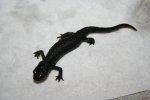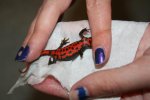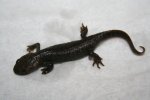AngieD
New member
- Joined
- Sep 20, 2011
- Messages
- 388
- Reaction score
- 5
- Points
- 0
- Location
- Cheshire
- Country
- England
- Display Name
- Angie
I have had a careful look at the species guides, and I'm still having trouble identifying what species of fire-belly our pair are.
I'm reasonably sure the male (Pyro) is a japanese, because of the pointed tail, prominent glands, and the fact that he is currently grey with dark spots (although he didn't at the time the pictures were taken).
As for Nora, she has the elongated toes, pointed tail and prominent glands of a japanese, but still somehow looks like a chinese.
We don't know the source of these newts, as the friend we bought them from said they had a few owners before he got them.
I was wondering if anyone could clear up this confusion
Thanks in advance
I'm reasonably sure the male (Pyro) is a japanese, because of the pointed tail, prominent glands, and the fact that he is currently grey with dark spots (although he didn't at the time the pictures were taken).
As for Nora, she has the elongated toes, pointed tail and prominent glands of a japanese, but still somehow looks like a chinese.
We don't know the source of these newts, as the friend we bought them from said they had a few owners before he got them.
I was wondering if anyone could clear up this confusion
Thanks in advance




